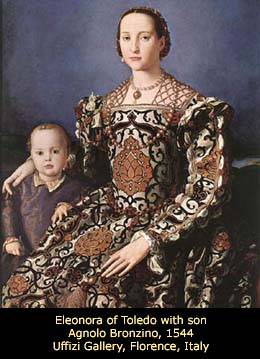Eleonora de Toledo with her son
Agnolo Bronzino, 1544 - 1545
Italian Mannerism
Galleria degli Uffizi, Firenze, Italy
Agnolo Bronzino, a pupil of Jacopo Pontormo, from 1539 until his death in 1572 was a court painter to the first absolute ruler of Firenze, Cosimo I de Medici. His elegant portraits of duke, duke's wife, family and courtiers are outstanding examples of Tuscan High Mannerist style. His portraits reveal his outstanding skills as a draughtsman, brilliantly expressing the rigid pride of his aristocratic sitters as well as capturing the detailed patterning on their dresses.
Eleonora of Toledo, daughter of Don Pedro de Toledo, viceroy of Naples, and Donna Maria Pimentel, Marquise of Villafranca, was born in 1522. She was the most beautiful of their four daughters: Isabel, Eleonora, Juana and Ana. Because of political calculations and awareness of dynastic tradition for foreign bride Cosimo I de Medici (1519 - 1574) asked for Eleonora's hand. Three years later on January 28 1538 Eleonora was married by proxy to Duke of Florence. She was conscious of her family origin and her position at her husband's side. She had haughty austere temperament established by her dynastic standing which did not make her much loved by the Florentines. They did not welcome her walking along the streets dressed in sumptuous clothes, surrounded by her guards and servants. However, Cosimo did not allow them to interfere in any way in the life of his court. In contrary duke loved her, respected her and gave her all necessary power to represent him during his long journeys. In 1541 he declared her a regent. Eleonora was very concern for the fortunes of their estate. In fact, she was very successful Renaissance business woman. She preoccupied herself in very profitable business of purchase and sale of real estate, and house and farm estates with concession of money loans. She was also involved in agricultural activities of turning abandoned, devastated by war or uncultivated lands into fertile areas and sold or leases them out with immense profit. (Historical sources report that her great grandson grand duke Cosimo III continued her agricultural activities with great economical success.) In a short time she accumulated considerable wealth by dealing with the trade in corn and other foodstuffs. She also intensified selling fish from the Buriano Lake which brought her another great deal of money. To complete her brief business outline she also invested a great deal of money in Florentine, Spanish and Neapolitan government bonds by buying bank deposits or fiscal revenues. Her fortunate economic activities contributed in prosperity of Florentine arts and higher education. She founded Jesuit Collego in Florence, which Father Lainez took under his spiritual guidance. She also began the construction of a convent for the wives and daughters of the Knights of Santo Stefano. Her death in 1562 caused by tuberculosis did not permit her to finish her project. However, after her death the construction was carried on by her husband and sons, Francesco and Ferdinando, using the legacies left in her will. Thanks to Eleonora Palazzo Pitti was purchased, restored, redesigned and redecorated to the shape which can still be admired today. Thanks to her money great architect Giorgio Vasari could begin the construction of Palazzo degli Uffizi, the building designed by him to hold the most important judicial offices. She also actively patronized to the painter Angolo Bronzino (1503 - 1572).
As court painter to the Medici in Florence, Bronzino produced large numbers of portraits.
His stylized portraits in their long lines and elegant poses were highly admired by his Medici patrons.
A famous example is the portrait of
Cosimo's wife "Eleonora of Toledo and her Son Giovanni" (ca. 1544, Uffizi Gallery
in Florence). In this charming portrait by Bronzino Eleonora is posed regally, gazeing the viewer with
an assured stare of
her importance to the dynasty as a wife, a mother, a mistress of the house, a regent and a business woman.
The intense blue of the background of the picture
and the stateliness of the figure enhance the marvelous beauty of Eleonora's dress
which visually slightly overwhelms the figures in the picture.
Her dress is of embroidered brocaded satin with piping and netting at
the shoulders interspersed with pearls. She wears two pearl necklaces, the smaller
having a pendant jewel and pear-shaped pearl. On her head she wears a hairnet
decorated with pearls. Her dress is decorated also with a tassel made of pearls
that fits to her hairnet.
Her aristocratic beautiful face betrays a sense of melancholy.
In the left corner of the panel her two years old son Giovanni leans against his
mother resting his left hand on her dress.
Rather than revealing the sitter's character, Bronzino treated
jewelry, costumes, and surrounding architecture of the setting as precious, rare and
immutable substance.
He paid Flemish attention to depicting details like his sitters' lace collars,
hair, and jewelry, and even the veins in their hands gave his portraits
a remote decorativeness. In 1857 when the Medici tombs were opened to enable the inspection
of the state of interment. Her body was found still clothed in the sumptuous gown she was buried in,
which looked exactly the same as in the painting.
His emotionally inexpressive, reserved, decorative and elegant portraits inspired the development of
European portraiture for the next centuries (Leighton and Ingres for example).
As court artist Bronzino was required to supply as many images as was needed.
The 5 original versions of this picture are known:
Gallery degli Uffizi, Firence, Italy; Hrtmitage, St. Petersburg, Russia,
The Detroit Institute of Arts, Detroit, USA,
and two others in the private hands.
